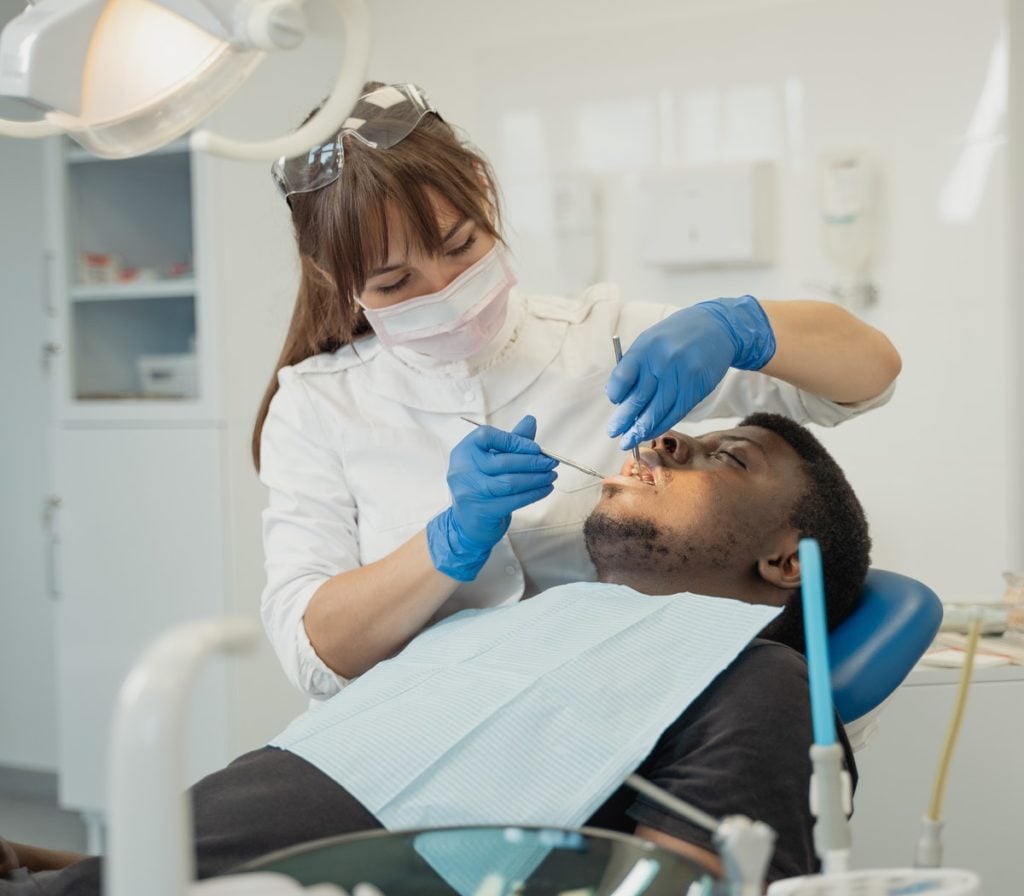Conversion rate optimization, referred to as CRO, and UX, or User Experience, has become the focus of dental marketing and dental flow.
In the digital age, everything must work together—from your support and customer service to your team and your technology.
Although user experience relates to how users feel when they interact with your dental practice, conversion rate optimization is more structured. CRO helps you and your team identify and eliminate any problems with user experience.
What is a good website conversion rate?
Identifying what website conversion entails is a vital component of calculating and understanding your website conversion rate. Whenever an individual comes across your website or Google Business Profile and reaches out to your dental practice (either by phone, email, etc.), they convert into a lead. A typical website conversion rate for these leads in the dental industry should be between three to five percent. Of all the leads that you gain from your online marketing efforts, 30% to 50% of them should become patients of yours.
The simple way to convert leads into customers is to start with the free resources you already have intact, like your current employees. In addition to the everyday office tasks, it is your receptionist’s major responsibility to ensure they are not just answering questions but persuading those curious individuals towards becoming a patient.
Investing in lead-generating software can automatically convert your leads into patients by persuasively answering their questions through live chats and SMS messaging. Podium can help manage your website leads and communications through SMS. Get started with Podium today for free.

How do I make a website conversion?
A vital part of your website conversion includes providing the experience your target audience wants. Your future customers want to see the obvious differentiator between you and your competitors. Why are you better than the dental practice down the street from you? What is your value proposition? Best practices today show that providing customer testimonials on your website’s home page and focusing on review management will help you win patients over your competitors.
Why is my site not converting?
The simple answer is you need to focus on your visitors’ experience by optimizing your website conversion rate. Make sure the website goal is met by also appealing to the wants and needs of the visitor. Every user can be different, so we’ve made it easy by compiling 20 tips to enhance your marketing efforts and improve your overall website conversion rate.
20 Tips on how to optimize your website for conversion.
User experience basics for a landing page.
From the moment the user lands on your website from Google to whenever they leave your website, you need to create the experience your audience craves by meeting their needs in a visually appealing manner. Here are some basic best practices to help conversion rates.
1. Watch your navigation
Let’s face it; if a potential patient can’t figure out how to get through your website, they will most likely go to the next dentist on the list. If your dental website is hard to follow, talk to your webmaster, or have your website redesigned. You want your site to be easy to use, especially when it comes to FAQs and contact information.
2. Be mobile-friendly
Since 2016, Google has been making mobile search a priority. Mobile-first indexing is vital for user experience and search engine optimization, or SEO. People use mobile phones to make dental appointments and to read reviews. If you are not mobile-friendly, talk to Dentainment about a mobile-friendly website.
3. Don’t be slow to load
Page speed is essential, regardless of the device. If your dental page takes too long to load, think less than 5 seconds, your bounce rate will go through the roof. Think about how long you wait for a page to load, and you will quickly understand how important page speed is to your CRO and UE. Look for different things that may be slowing your website down, like unnecessary pop-ups, videos, etc.
4. Get to the point
Your Meta description (what people see in the search engine results) should be clear and concise. When you write your blogs and landing pages and add new content to your website, make sure you are focused. People don’t want to go to a page led by a description that has nothing to do with what’s on the page.
5. Be thoughtful with customer service
Customer service is something all dental practices need to pay attention to, especially in the digital age. Use a texting program, chatbots, or artificial intelligence so that people who are interested in your dental practice can get in touch with you in real-time. There is nothing like good old-fashioned customer service to boost dental flow.
6. Use digital technology
If you’re not embracing digital technology or just don’t have the time, you’re missing out. Write your content so that it’s geared towards voice search. Start a monthly email newsletter and reach out to your patients (and potential ones) via social media. Don’t forget to create email lists so that you can personalize your content as well.
7. Video marketing
Right at the top of the list, when it comes to UE, is video. People are more inclined to reach out with a video than they are with text. Even photos don’t grab as much attention as videos. With today’s platforms, such as YouTube, Vimeo, and Wistia, it’s easy to create a compelling video marketing campaign for your dental practice.
8. Page optimization
Page optimization is important for both UE and CRO. When you optimize your content, it makes it easier for patients, as well as potential ones, to find you. Go back over your title tags and Meta descriptions and revisit your content for readability. It’s true that page optimization helps everyone and will boost your bottom line.
9. Keyword optimization
Keywords and Keyword Phrases are just as essential as they used to be. Keywords also help with User Experience. When you place the appropriate phrases and keywords in your online content, it helps potential patients and website visitors find your dental practice. Use an online keyword finder if you are unsure of the most popular keywords.
10. Create talkable content
With voice search leading the way with customer queries, creating conversational content is imperative. Typing a question into a search bar is totally different than saying it aloud. Before your start writing for voice search, think about how you would ask the question verbally, and go from there.
CRO basics for website conversions.
11. Get feedback from your patients
If you aren’t communicating with your patients, you won’t get good feedback. Talk to your patients and your fans and followers on social media. Ask users to leave you feedback and reviews, as most people will read what others have to say about your dental practice before making an informed decision.
12. Use surveys for an honest opinion
Surveys are an excellent way to get feedback from your patients. Your surveys could include anything from how they feel about their visit to suggestions for new products and services. You could even do a bi-yearly or annual survey for patients and your social media audience.
13. Find out what people are looking for
It’s easy to check out what people are looking for on your website. Google Search Console is one of the most reliable online tools available. Google Search Console allows you to look for the search terms that people use on Google. You can also gather information using Google Analytics and Google Service Provider.
14. Check out your trust factor
Just like word of mouth, your online reputation is what builds dental flow. It’s important to develop a strategy that can build and strengthen your reputation. You can build your trust factor by creating value. Like any other business, your dental brand needs to be something that people can rely on, something they can trust.
15. Consistency is the key
Maintain your consistency on all platforms and create helpful and educational content. Be authentic and transparent. Address queries and less-than-positive comments. Prove your social identity with reviews, case studies, and testimonials. Be consistent throughout with your narrative, logo, and colors as well.
16. Be unique
Nobody likes a copycat. In fact, Google and the other search engines will punish you for it. Copying and pasting someone else’s content won’t improve CRO or UE, but more important, it’s against copyright law. Make sure to always focus on quality, consistent and relevant content for your website.
17. Listen socially
Social listening will help with CRO. Remember, users tend to say what is on their minds when they are behind a keyboard. If you are not socially listening, those comments could damage your reputation. When you stay in touch with posts and engage on Facebook and Instagram, you acknowledge fans’ and followers’ praise and pain points.
18. Don’t forget your call to action
Your Call to Action (or CTA) has always been important; however, it is imperative that you follow the rules. Make it personal and keep your CTA above the fold. Don’t blend it in with the rest of your website and make it abundantly clear that it is a CTA. Think “BOOK MY APPOINTMENT” or “DESIGN MY SMILE.” Most importantly, don’t bombard your page with CTAs.
19. Use an interactive Webchat feature
WebChat is the fastest and most efficient way to capture new website leads. By implementing the Podium WebChat, you will be able to move conversations to text and drive new patients much easier than traditional methods.
20. Don’t forget about Alexa and Siri
Voice-based apps are multitasking in everyone’s lives these days. From asking Alexa for a recipe to enquiring about menus, voice-based apps aren’t going anywhere. Voice-based apps can help with CRO and increase brand visibility using Google Actions or Alexa Skills.
SEO and CRO working together to meet conversion goals.
Both SEO and CRO perform well together—when there is a shared goal. Although SEO can sometimes harm your conversion (just as conversion can damage your search engine optimization), they do have one thing in common. However, focusing on the bottom line and your CRO, one hundred percent of the time, can cause problems for your overall dental marketing strategies.
Combine powerful stories with an awesome design.
One of the best ways to boost SEO and CRO is to develop a unique brand across all platforms. Brands that tend to copy each other appear inauthentic. You can grow closer to your audience by sharing and telling great stories about you, your dental practice, and your team. When you show your emotions, you are creating value as well.

Bottom line
Having a unique and powerful message is important, but so is tying everything together. If your brand is convoluted and your message confusing, potential patients may just decide to give your dental practice a pass.
If you are unsure how to successfully combine your User Experience with your Conversion Rate Optimization, consider working with marketing professionals in the dental industry.






